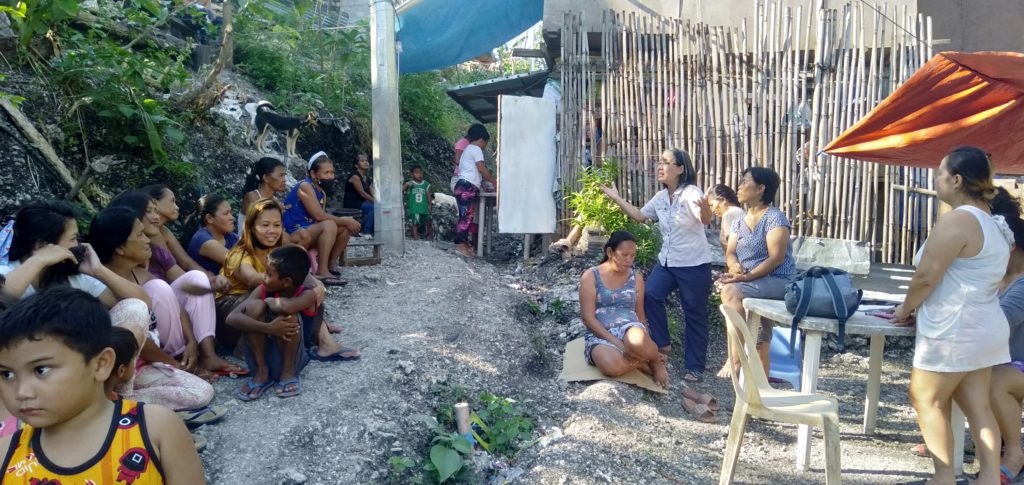![]() The second quarter of the second year of the health project supported by the Committee of German Doctors for Developing Countries advances the project goal to provide needed primary health care services to three communities by trained community health workers (CHWs) and for the residents to be self-reliant on primary health care.
The second quarter of the second year of the health project supported by the Committee of German Doctors for Developing Countries advances the project goal to provide needed primary health care services to three communities by trained community health workers (CHWs) and for the residents to be self-reliant on primary health care.
The communities include SitioSawsawan, San Roque, Talisay City, PurokTambis, Umapad, Mandaue City and SitioIntramuros, Barangay Poblacion, Cordova.
In the three areas, the CHWs continued to do home visitations to find out who were sick and rendered home remedies.
Residents who cannot be managed by the CHWs were quickly referred to the Talisay health center, the Cordova health center and in Umapad, the Cebu Institute of Medicine community hospital in neighboring barangay Paknaan. There were many times that the CHWs personally brought the sick patients to the hospital in Paknaan.
Health educations were conducted to address common health issues existing in the barangays, providing information to the residents to enable them to prevent illnesses and maintain health and launching community endeavors together. Primary health problems included the following, namely: (a) infectious diseases particularly acute respiratory tract infections, diarrheal diseases, and pulmonary tuberculosis, (b) chronic diseases such as hypertension and diabetes (c) child health care particularly nutrition and growth monitoring, and skin infections and (d) reproductive health including family planning, safe motherhood.
Mothers with children with common cough and colds were taught home remedies including to give the child more fluids and extra nutrition and use lagundi as cough syrup. The sick children were followed up by the CHWs after three days of herbal medicine in order to find out if they did not worsen to pneumonia by simply counting the respiratory rate. If so, the CHWs brought the sick children right away to the health centers.
Mothers with children having diarrhea cases were given homemade oral rehydration salt solution by the CHWs which consisted of one tablespoon of sugar and a pinch of salt in a liter of clean water. Environmental sanitation drives such as that in Umapad are ongoing. The youth group conducts operation clean-up every week and rice sacks are conspicuously set up for garbage disposal and brought to the main highway for garbage trucks to pick up for disposal.
To address the problem of pulmonary tuberculosis, the CHWs conducted health educations on the signs and symptoms of TB, such as chronic cough, weight loss, afternoon fever, and hemoptysis which increased the awareness of the residents on the disease. Patients with the symptoms were then referred to the health centers by the CHWs for sputum examination; with sputum positive for the TB germs, they were given medication right away. Those with negative acid-fast-bacilli results were then advised to have chest X-ray in accordance with the government’s Department of Health (DOH) tuberculosis control program.
To address the problem of hypertension which is the number one cause of death in the Philippines, the hypertension control program was sustained by the CHWs through health educations, home visitations and taking the blood pressure of the adults. Eventually, they didn’t have to since the residents themselves went to the houses of the CHWs since they were now more aware through the health education and information drives of the complications of uncontrolled hypertension.
The provision of anti-hypertensive medications was sustained by referring the patients to the government health centers. In cases when they were not available, the CHWs secured cheap medications from the project staff who got them from the supplier of medications of the German Doctors rolling clinic. They were then sold to the patients with a very small profit margin.
The problems of osteoarthritis, muscle pains, and tension headache as chronic illnesses which are work and fatigue related among the urban poor were addressed by the CHWs using herbal liniment made of coconut oil soaked with crushed garlic, red pepper and ginger which were cooked in the oil. The warmth of the oil with the healing ingredients of the spices soothed aching joints and headache. Cupping therapy for muscle aches and acupressure for headache were also practiced by the CHWs and taught.
The nutrition program is also sustained in the three barangays. Operation weighing of children less than six years old is ongoing. Mothers of identified malnourished children were counselled regarding proper nutrition. In Umapad, the children benefit from a feeding program of the Justice, Peace and Integrity of Creation. Vegetable gardens are also grown in pots outside the houses in Umapad and Sawsawan and in small lawns in Intramuros.
Skin infections among children were addressed through health education on proper hygiene and treatment not by expensive Western ointments but by temple flower, moringa and hemlock stem coverings that are shredded and cooked in vegetable oil and added with paraffin wax.
Home remedies such as water therapy, cupping therapy, acupressure and herbal plants were constantly resorted to by the CHWs for patients who have ordinary complaints such as fever, cough and colds, stomach ache, headache, body aches and body malaise. The use of essential Western drugs was resorted to by the CHWs when these traditional forms of medicine failed or to complement their use. These included paracetamol for fever, amoxicillin for ordinary infections, antacids for stomach problems.



